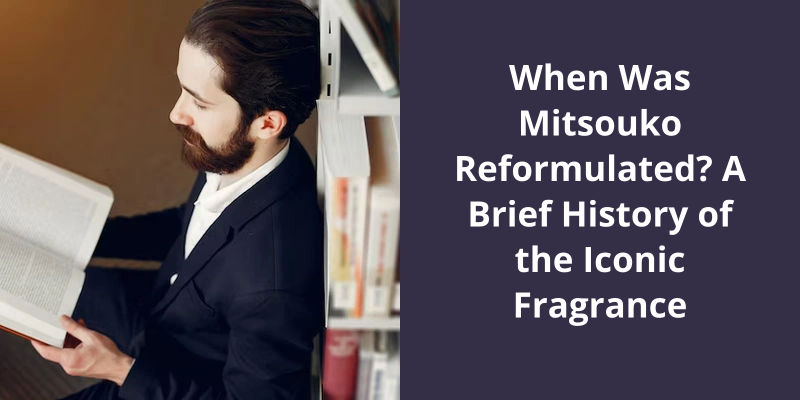Mitsouko, the iconic fragrance, has experienced several reforms since its creation in 1919. While it’s difficult to pin down the exact dates of all reforms, notable changes were made in the 1970s due to restrictions on the use of certain natural ingredients. Further significant changes were made during the late 2000s and 2013 due to regulatory restrictions on oakmoss and other ingredients. The 2013 reformulation was probably the most notable, as it involved the reduction of oakmoss, which significantly affected the scent’s character. Despite these changes, Mitsouko continues to be a beloved fragrance worldwide.

Has Mitsouko Changed?
However, the essence of Mitsouko has remained unchanged in many respects. It still embodies that sense of mystery that was imbued into it 100 years ago. The unique combination of fruity and woody notes still remains as captivating and intriguing as it was when it was first created. Mitsouko is still a fragrance that demands attention and respect, and one that continues to captivate the imagination of fragrance connoisseurs around the globe.
It continues to resonate with people of all ages and backgrounds and continues to captivate the imagination of fragrance enthusiasts everywhere. For many people, it isn’t just a fragrance, but a work of art and a symbol of timeless elegance and sophistication.
It remains a benchmark for the industry and has stood the test of time, evolving and adapting along the way while still retaining the essence of what made it so special when it was first created.
A History of the Mitsouko Fragrance and the Story Behind It’s Creation.
- In 1919, Guerlain launched the Mitsouko fragrance, which has since become a classic in the world of perfumery.
- The scent was inspired by the novel “La Bataille” by Claude Farrère, which tells the story of a Japanese woman named Mitsouko who awaits her lover, a British officer, during the Russo-Japanese War.
- The fragrance is meant to embody the contrast between fierce and delicate feminine strength and was groundbreaking for it’s use of the synthetic molecule, coumarin, which had never before been used in perfume.
- Over the years, the fragrance has evolved using different blends of ingredients, but the original scent remains as iconic as ever.
- Mitsouko has been worn by legendary figures such as Marlene Dietrich, Jacques Guerlain’s muse, and has influenced other fragrances, including Karl Lagerfeld’s Chloe.
The name Mitsouko isn’t just a name but a symbol of mystery and closeness. Created by Jacques Guerlain for the perfume Mitsouko, the name is derived from the French transliteration of a Japanese female personal name Mitsuko, which can also be written with the character 密, meaning both “closeness” and “secret.” As a result, the name Mitsouko can have various interpretations, from shine to secret.
What Does the Name Mitsouko Mean?
The name Mitsouko has several meanings, depending on it’s interpretation. As mentioned earlier, it’s a French transliteration of the Japanese female name Mitsuko. However, when written with the character 密, it takes on a whole new dimension. This particular character can mean both “closeness” and “secret.”
Jacques Guerlain, the creator of the Mitsouko perfume, was a master at incorporating different cultures and languages into his work. By choosing a name with multiple meanings, he was able to add more depth and intrigue to his fragrance. Mitsouko was not just a scent but a story waiting to be told.
The novel “La Bataille” by Claude Farrère is said to have influenced Jacques Guerlain in his creation of Mitsouko. The character Mitsouko in the novel is a Japanese woman who falls in love with a naval officer. The perfume was the embodiment of this tragic love story, with it’s notes of peach, jasmine, and oakmoss symbolizing the complex emotions of the protagonist.
Mitsouko remains a popular fragrance today, more than a century after it’s initial release. It’s name adds to it’s mystique and allure, providing a perfect complement to it’s unique scent. The name Mitsouko continues to fascinate fragrance enthusiasts, with it’s various interpretations and cultural influences never failing to captivate it’s audience.
The History of Guerlain Perfumes and Their Impact on the Fragrance Industry
- Guerlain Perfumes founded in 1828 by Pierre-François Pascal Guerlain.
- First fragrance, called Eau de Cologne Imperiale, was created for the French Emperor Napoleon III and his wife Eugenie.
- In 1889, Guerlain launched Jicky, a fragrance that’s considered the first modern perfume and had a major impact on the fragrance industry.
- In 1912, Guerlain introduced L’Heure Bleue, a timeless classic that still remains popular today.
- In 1925, Guerlain launched Shalimar, a fragrance that’s considered one of the greatest perfumes of all time and revolutionized the perfume industry.
- Guerlain continues to create iconic fragrances, including Samsara, Mitsouko, and La Petite Robe Noire.
- The impact of Guerlain perfumes on the fragrance industry is still felt today, as many perfumers continue to draw inspiration from their classic scents and innovative techniques.
Conclusion
In conclusion, the formulation and reformulation of fragrances represent a continuous process of improvement and evolution, guided by the ever-changing consumer preferences, regulatory requirements, and ingredient availability. While the history of Mitsouko, one of the most iconic fragrances of all time, has been marked by several reformulations, each iteration has sought to preserve the distinctive chypre character of the original, while adapting to the exigencies of the times. From it’s creation in 1919 by Jacques Guerlain to it’s latest reformulation in 2013, Mitsouko has remained a testament to the artistry and innovation of the perfume industry, captivating generations of wearers and inspiring countless other fragrances.





